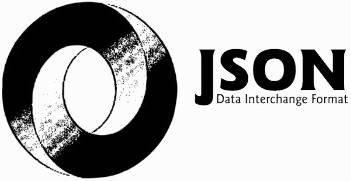Web Programming Step by Step, 2nd Edition
Lecture 23: JSON
Reading: 12.4
Except where otherwise noted, the contents of this document are Copyright 2012 Marty Stepp, Jessica Miller, and Victoria Kirst. All rights reserved. Any redistribution, reproduction, transmission, or storage of part or all of the contents in any form is prohibited without the author's expressed written permission.
Pros and cons of XML
- pro:
- standard open format; don't have to "reinvent the wheel" for storing new types of data
- can represent almost any general kind of data (record, list, tree)
- easy to read (for humans and computers)
- lots of tools exist for working with XML in many languages
-
con:
- bulky syntax/structure makes files large; can decrease performance (example)
- can be hard to "shoehorn" data into a good XML format
- JavaScript code to navigate the XML DOM is bulky and generally not fun
JavaScript Object Notation (JSON)


JavaScript Object Notation (JSON): Data format that represents data as a set of JavaScript objects
- invented by JS guru Douglas Crockford of Yahoo!
- natively supported by all modern browsers (and libraries to support it in old ones)
- not yet as popular as XML, but steadily rising due to its simplicity and ease of use
Recall: JavaScript object syntax
var person = {
name: "Philip J. Fry", // string
age: 23, // number
"weight": 172.5, // number
friends: ["Farnsworth", "Hermes", "Zoidberg"], // array
getBeloved: function() { return this.name + " loves Leela"; }
};
alert(person.age); // 23
alert(person["weight"]); // 172.5
alert(person.friends[2])); // Zoidberg
alert(person.getBeloved()); // Philip J. Fry loves Leela
- in JavaScript, you can create a new object without creating a class
- the object can have methods (function properties) that refer to itself as
this - can refer to the fields with
.fieldNameor["fieldName"]syntax - field names can optionally be put in quotes (e.g.
weightabove)
An example of XML data
<?xml version="1.0" encoding="UTF-8"?> <note private="true"> <from>Alice Smith (alice@example.com)</from> <to>Robert Jones (roberto@example.com)</to> <to>Charles Dodd (cdodd@example.com)</to> <subject>Tomorrow's "Birthday Bash" event!</subject> <message language="english"> Hey guys, don't forget to call me this weekend! </message> </note>
The equivalant JSON data
{
"private": "true",
"from": "Alice Smith (alice@example.com)",
"to": [
"Robert Jones (roberto@example.com)",
"Charles Dodd (cdodd@example.com)"
],
"subject": "Tomorrow's \"Birthday Bash\" event!",
"message": {
"language": "english",
"text": "Hey guys, don't forget to call me this weekend!"
}
}
Browser JSON methods
| method | description |
|---|---|
JSON.parse(string)
|
converts the given string of JSON data into an equivalent JavaScript object and returns it |
JSON.stringify(object)
|
converts the given object into a string of JSON data (the opposite of JSON.parse)
|
- you can use Ajax to fetch data that is in JSON format
- then call
JSON.parseon it to convert it into an object - then interact with that object as you would with any other JavaScript object
JSON expressions exercise
var data = JSON.parse(ajax.responseText);
{
"window": {
"title": "Sample Widget",
"width": 500,
"height": 500
},
"image": {
"src": "images/logo.png",
"coords": [250, 150, 350, 400],
"alignment": "center"
},
"messages": [
{"text": "Save", "offset": [10, 30]}
{"text": "Help", "offset": [ 0, 50]},
{"text": "Quit", "offset": [30, 10]},
],
"debug": "true"
}
Given the JSON data at right, what expressions would produce:
- The window's title?
- The image's third coordinate?
- The number of messages?
- The y-offset of the last message?
var title = data.window.title; var coord = data.image.coords[2]; var len = data.messages.length; var y = data.messages[len - 1].offset[1];
JSON example: Books
Suppose we have a service books_json.php about library books.
-
If no query parameters are passed, it outputs a list of book categories:
{ "categories": ["computers", "cooking", "finance", ...] } -
Supply a
categoryquery parameter to see all books in one category:
http://webster.cs.washington.edu/books_json.php?category=cooking{ "books": [ {"category": "cooking", "year": 2009, "price": 22.00, "title": "Breakfast for Dinner", "author": "Amanda Camp"}, {"category": "cooking", "year": 2010, "price": 75.00, "title": "21 Burgers for the 21st Century", "author": "Stuart Reges"}, ... ] }
JSON exercise
Write a page that processes this JSON book data.
- Initially the page lets the user choose a category, created from the JSON data.
-
After choosing a category, the list of books in it appears:
Books in category "Cooking":
- Breakfast for Dinner, by Amanda Camp (2009)
- 21 Burgers for the 21st Century, by Stuart Reges (2010)
- The Four Food Groups of Chocolate, by Victoria Kirst (2005)
Working with JSON book data
function showBooks(ajax) {
// add all books from the JSON data to the page's bulleted list
var data = JSON.parse(ajax.responseText);
for (var i = 0; i < data.books.length; i++) {
var li = document.createElement("li");
li.innerHTML = data.books[i].title + ", by " +
data.books[i].author + " (" + data.books[i].year + ")";
$("books").appendChild(li);
}
}
Bad style: the eval function
// var data = JSON.parse(ajax.responseText); var data = eval(ajax.responseText); // don't do this! ...
- JavaScript includes an
evalkeyword that takes a string and runs it as code - this is essentially the same as what
JSON.parsedoes, - but
JSON.parsefilters out potentially dangerous code;evaldoesn't evalis evil and should not be used!

